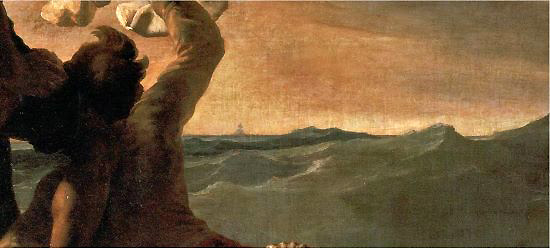"THE RAFT OF THE MEDUSA" ADAPTS NOBLES' USE OF MYTHOLOGY TO GIVE HUMBLE SAILORS THE BODIES OF GODS
 |
| By Théodore Géricault in 1818-1819. He was 27. |
# # #
Sailors on a raft in the high seas glimpse the ship that will save them:
- The very dark man highlights the hero's mixed blood to make him a symbol of all humanity (as the artist said explicitly):
- Mankind on high seas is a symbol of human fragility, the outstretched hand recalls Michelangelo's The Creation of Adam and the light on the horizon means hope.
# # #
The true story
- The king appoints as ship captain a man who has never been to sea, because he is a noble (in 1815).
- When he wrecks the ship off Mauritanian reefs he has sailors build a raft and climb onto it, promising that officers in a lifeboat will pull them to shore. Then he has someone cut the rope:
 | |
Abandon of the Raft of the Médusa, 1837 / zoom |
- After 13 days at sea, only 15 of the original 150 are still alive. They have survived by eating the dead:
Sketch / zoom
- Attacks the king for giving a position of such responsibility to an inept and cruel crony.
- Presents a Black who is not a subordinate at the height of the slave trade, for the first time since the 16th century.
- Inaugurates Romantic art, which was often rebellious.
# # #
Until then, huge paintings had portrayed elites only. Raft is the first to honor ordinary men with a canvas of such size.
Placing it next to a giant work of propaganda emphasizes its dissent:
.jpg) |
Napoleon at Eylau by Jean Gros, 1807-1808 / zoom |
Vito Locaturolo
# # #
Fifty years later another rebel would say,
"We are all on the raft of the Medusa...
When humanity has turned all its forces
against the obstacles that hold it back,
it will ride through the storm."
-- Louise Michel: later.
* * *
Next,
A goddess becomes a plebeian revolutionary

.jpg)








No comments:
Post a Comment